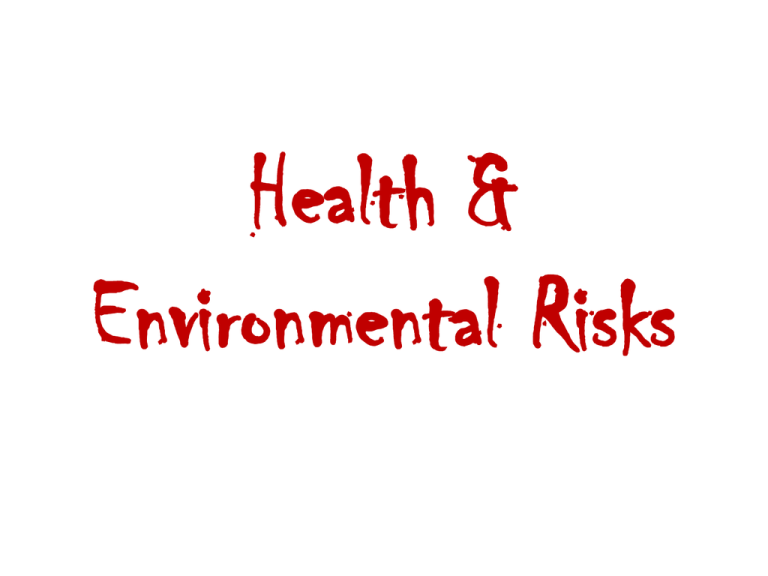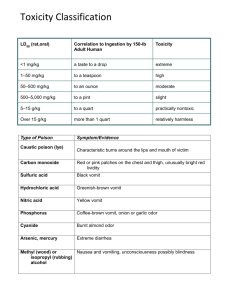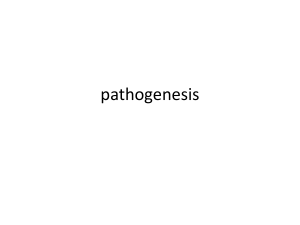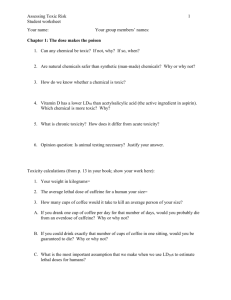Health & Toxicology notes
advertisement

Health & Environmental Risks Human Health Hazards 1. Physical – includes environmental factors such as natural disasters and exposure to UV radiation 2. Biological – includes exposure to pathogenic organisms bacteria that cause cholera Nontransmissible disease does not spread from one organism to another ex. Cancer, Diabetes Transmissible disease Caused by pathogens and can easily spread from one organism to another using vectors/carriers AKA Infectious disease Notable infectious diseases * Plague caused by a bacterium that is carried by fleas * Malaria caused by members of the protozoan genus called Plasmodium. The Anopheles mosquito is the vector. RBCs infected with Plasmodium * Tuberculosis (TB) caused by a bacterium that primarily infects the lungs and is highly contagious * HIV/AIDS viral disease that emerged in the late 1970s * H5N1 viral disease that emerged in 2006, the carriers are birds. Closely related to H1N1 (bird flu), but much more deadly. Factors that affect the spread of diseases Travel, migration, deforestation, climate change, loss of biodiversity, agriculture, urbanization, & nature disasters It sure is nice to get away from the colon for awhile 3. Chemical – includes exposure to naturally occurring and synthetic chemicals Toxins … chemicals that cause harm 5 main categories of TOXINS * Neurotoxins – disrupt the nervous system by attacking neurons or interfering with communication between neurons ex. DDT, PCB, dioxins, arsenic, organophosphate pesticides, etc * Carcinogens – cause cancer, uncontrolled mitosis (cell growth) ex. Asbestos, radon, formaldehyde, etc * Teratogens – chemicals that cause birth defects ex. alcohol, thalidomide (no longer available) * Allergens – chemicals that cause allergic reactions ex. chemicals in peanuts, milk, penicillin * Endocrine Disrupters – chemicals that interfere with the normal functioning of hormones in an animal’s body. aka Hormonally Active Agents (HAA) ex. atrazine and other pesticides Response of body to toxin can be…. Acute - immediate reaction OR Chronic - long term effects Toxicology … study of chemical risks Toxicity measure of the harmfulness of a chemical (dependent on toxin and the organism affected) Toxin Organism Dose Age Solubility (water or fat) How frequently exposure occurred Persistence Genetic makeup Interactions with other chemicals in the organism Health of detoxification systems Solubility of a toxin affects how readily it bioaccumulates in an organism and biomagnifies in an ecosystem. Persistence determines how long the toxin remains in the environment. How do scientists determine the toxicity of a chemical? 1. Dose-Response Studies (bioassays) Expose plants or animals(rats) to different amts of a chemical and observe responses The amount of the chemical is measured by… concentration (amount in air, water or food) or by dose (amount absorbed or consumed by the organism) Usually measure mortality as response Dose measurements and their equivalents Dose Metric Approx amount of water ppm mg/kg 1 tsp per 1000 gal g/kg 1 tsp per 1,000,000 gal ppb graph typically produced by data at the end of a dose response study The graph can be used to determine . . . * Threshold level – maximum point at which toxin does little or no harm * LD50 – Lethal Dose at which the toxin kills 50% of the organisms Threshold level: LD50: Poisons are toxins that have an LD50 of 50 mg/kg or less. Would the toxin represented above be a poison? Toxicity LD50 Lethal Dose Examples < 0.01 less than 1 drop dioxin, botulism mushrooms <5 less than 7 drops heroin, nicotine Very 5-50 7 drops to 1 tsp. morphine, codeine Toxic 50-500 1 tsp. DDT, H2SO4, Caffeine Moderate 500-5K 1 oz.-1 pt. aspirin, wood alcohol Slightly 5K-15K 1 pt. >15K >1qt. Super Extreme Non-Toxic ethyl alcohol, soaps water, table sugar (LD50 measured in mg/kg of body weight) At times toxicologists do not measure mortality but measure how a chemical may alter behavior. These are sublethal effects. * ED50 – Effective Dose at which the toxin causes 50% of the organisms to display harmful but not lethal effects. 2. Epidemiology Study of large populations of organisms exposed to chemicals in their everyday life and determines whether these exposures are related to any health problems. CAN BE Retrospective (past) ex. Bhopal disaster or Prospective (future) ex. track a target population & their habits Environmental Hazards Anything in the environment that can cause harm. pollutants, human activities, natural catastrophes, etc When policy makers, regulatory agencies, and environmental scientists assess the risk of a environmental hazard, they follow a three step process known as… Risk Analysis 1. Risk assessment includes identifying the hazard, determining it’s toxicity and the extent of exposure 2. Risk acceptance what is acceptable when balanced against social, economic and political considerations According to the EPA, a 1 in 1 million risk is acceptable for most environmental hazards. The EPA takes the LD50 & divides it by 10 for most animals to determine the safe concentration. Then divided by 10 again for humans. 3. Risk management Determine policy with input from private citizens, industry, and interest groups TSCA – Toxic Substance Control Act FIFRA Regulated by the EPA










